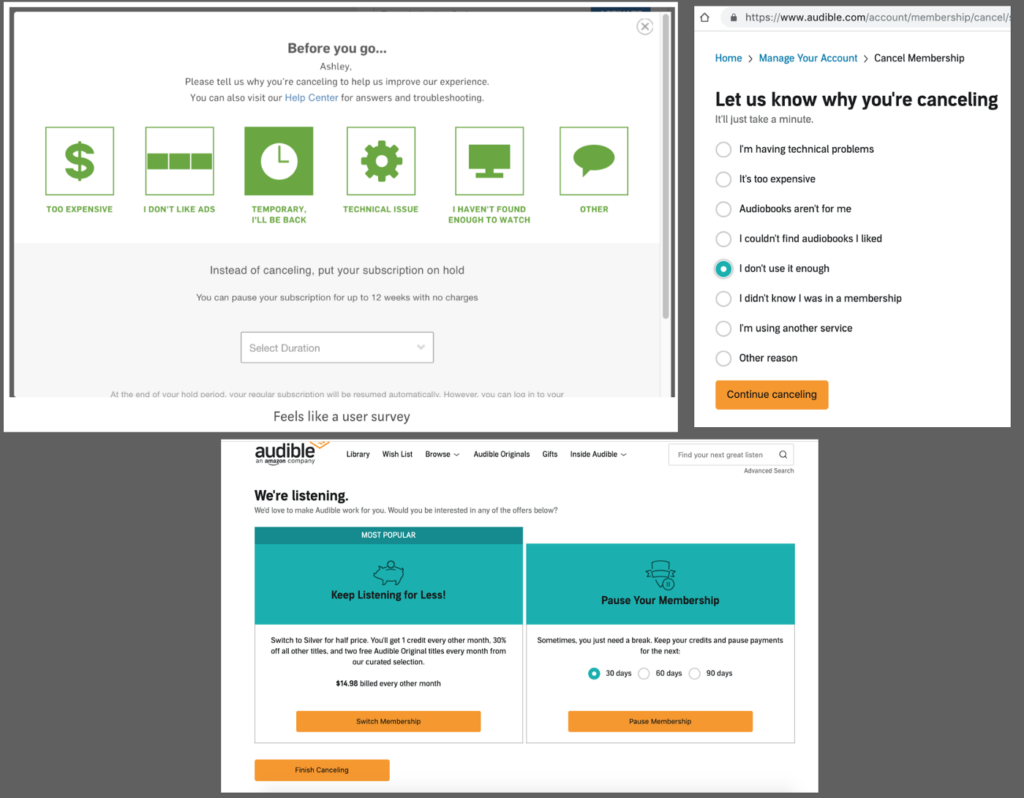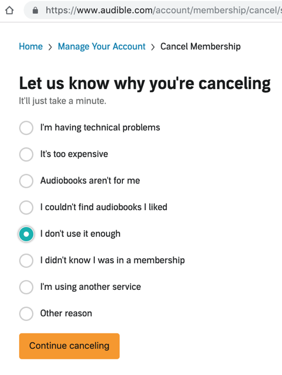Audible.com follows the HULU.com model of Coercive UI.
A while back I was cancelling my Hulu membership and it took me 4 tries.
I got so annoyed that I wrote a blog post about it. Recently I realized I had 5 credits on Audible.com and I had to admit that I wasn’t using the service. I’d been here before. 🤦🏼 5 months earlier when trying to cancel I allowed myself to be manipulated into to downloading 5 audio books which remain unlistened.

Apart from the scammy way in which they have ended my subscription on the date of cancellation — as opposed to ending it on the date of my next billing (which makes me feel cheated — even Hulu doesn’t cut your service off when you cancel, you paid for the month, you get the month) — there is a lot to disappoint here.
I would not be surprised if the Product Manager at Amazon who implemented this didn’t come over from or look up to Hulu as inspiration.
Up Next: let’s pretend “I’m just trying to improve my product” while I make it seem like feedback is required to complete the cancellation. Also I need to feed the next step in the recapture funnel.
I have to hand it to Hulu, they actually take care of this in 1 screen not two. They (Hulu) designed the user feedback to explicitly drive the next step in the recapture funnel. No matter which button you press you’re going to have at least 1 more step before you can cancel.

Given the monthly subscription fee is $15, and I’ve been manipulated into keeping this subscription against my instincts for 10 months, Audible made a cool $150 off of me with just a tiny bit of Coercive UX. That extra income makes this practice really attractive to a product manager or business GM. But it is wrong.
The UX crowd likes to call this practice Dark Patterns, but in an era where every one seems be entitled to their own facts and words have figuratively stopped having any literal meaning in the mouths of public figures, I prefer to name it what it is — coercive.
In my previous blog post I expressed a kind of moral neutrality to the practice. In my previous blog post I expressed a kind of moral neutrality to the practice. That’s not surprising, considering that I, like many of you, make my living trying to convert users. But I’m a fan of being self aware, and I’m aware this is immoral design. It doesn’t mean I won’t continue to use such practices in similar ways myself — but I’m going to try thinking more about my users and caring more about those people than my company’s profits. I get furious when I encounter this stuff and when it happens to people I care about my blood starts to boil. The only way I can imagine a product manager can be okay with this practice is if they are just not engaging in empathy with their customers — who are people. Can you imagine the facial expressions you’d get if you tried this in person, face to face?

For Amazon, a company that in many other ways leads with customer obsession, this is a clear fail.
Customer Obsession. Leaders start with the customer and work backwards.
If you are a product manager at Hulu or Audible and have a solid defense of this practice I’d love to hear it. Just At me on the Twitter. @ashr

